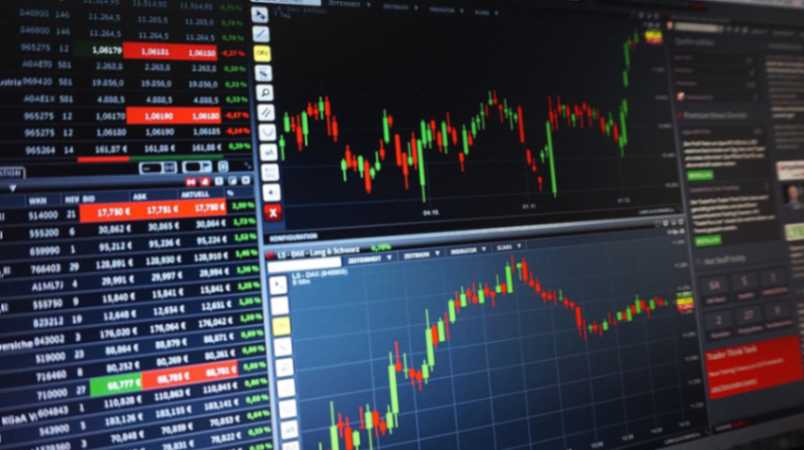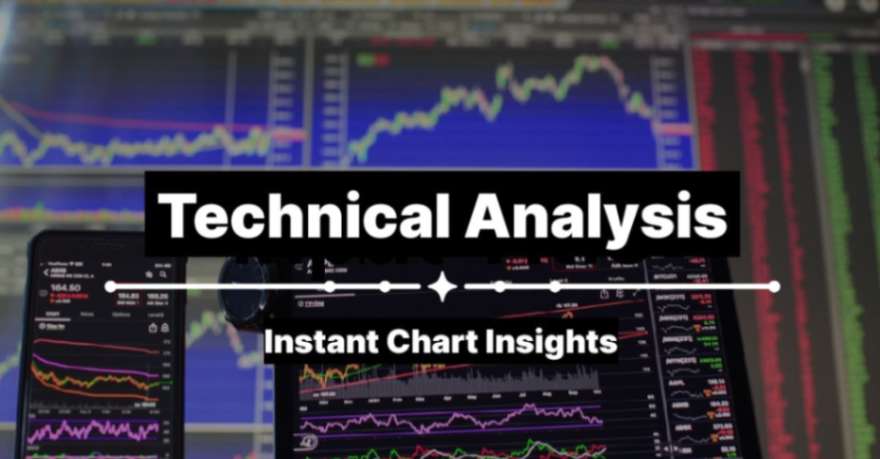This time we have come with information about top technical analysis. It is a method that helps traders understand and predict every move of the market. It gives an idea of future price movements through price patterns, charts, and indicators, which helps you know when to buy and when to sell.
Trading without top technical analysis can be risky, as there is volatility and sudden changes in the market. Therefore, it is important for beginners to understand the must-watch indicators of top technical analysis. These indicators give you real-time signals, such as Moving Averages (MA), which indicate trend direction; the Relative Strength Index (RSI), which shows overbought and oversold conditions; and the MACD, which captures momentum and trend changes. In addition, Bollinger Bands measure volatility, and volume confirms price moves. Fibonacci Retracement and Support/Resistance levels are also key, as they help decide entry and exit points. They can also be called Live Market Indicators. By combining and using these indicators in top technical analysis, you get strong and reliable signals.
Just remember, no indicator is 100% accurate, so use 2-3 indicators together and make sure to check the volume. Finding top technical analysis takes time and practice, but once mastered, it will become a solid foundation for your trading. So get started now, and make your trades smart and confident
Why Top Technical Analysis Matters in Trading
 Top technical analysis is a game-changer in trading because it equips traders with the tools to decode market behavior and make informed decisions. Unlike fundamental analysis, which focuses on a company’s financial health, top technical analysis zeroes in on price movements, trends, and patterns, offering instant chart insights that help traders react swiftly to market shifts. These insights are crucial in fast-paced markets where timing is everything. For instance, indicators like Moving Averages and Bollinger Bands provide real-time trading signals, alerting traders to potential entry and exit points. A Moving Average crossover can signal a trend reversal, while Bollinger Bands can indicate overbought or oversold conditions, prompting traders to act before the market corrects. This ability to access real-time trading signals gives traders a competitive edge, allowing them to capitalize on opportunities as they arise. Moreover, top technical analysis isn’t just for seasoned pros; it’s accessible to beginners too, thanks to user-friendly platforms like TradingView, which offer instant chart insights at the click of a button. By mastering top technical analysis, traders can navigate volatile markets with confidence, reduce emotional decision-making, and ultimately improve their profitability. In a world where markets can turn on a dime, having the right tools to interpret price action is not just helpful—it’s essential.
Top technical analysis is a game-changer in trading because it equips traders with the tools to decode market behavior and make informed decisions. Unlike fundamental analysis, which focuses on a company’s financial health, top technical analysis zeroes in on price movements, trends, and patterns, offering instant chart insights that help traders react swiftly to market shifts. These insights are crucial in fast-paced markets where timing is everything. For instance, indicators like Moving Averages and Bollinger Bands provide real-time trading signals, alerting traders to potential entry and exit points. A Moving Average crossover can signal a trend reversal, while Bollinger Bands can indicate overbought or oversold conditions, prompting traders to act before the market corrects. This ability to access real-time trading signals gives traders a competitive edge, allowing them to capitalize on opportunities as they arise. Moreover, top technical analysis isn’t just for seasoned pros; it’s accessible to beginners too, thanks to user-friendly platforms like TradingView, which offer instant chart insights at the click of a button. By mastering top technical analysis, traders can navigate volatile markets with confidence, reduce emotional decision-making, and ultimately improve their profitability. In a world where markets can turn on a dime, having the right tools to interpret price action is not just helpful—it’s essential.
That’s why top technical analysis matters: it turns data into actionable intelligence, empowering traders to stay ahead of the curve.
Getting Started with Top Technical Analysis: Key Concepts
Getting started with top technical analysis is like learning to read the market’s language. At its core, top technical analysis studies price movements, volume, and historical data to predict future trends. Unlike fundamental analysis, which digs into a company’s financials, top technical analysis focuses on charts and indicators to spot patterns like trends, reversals, or breakouts. Key concepts include understanding price action—how prices move over time—and recognizing signals from tools like moving averages, RSI, or MACD. For beginners, mastering top technical analysis starts with learning chart basics, such as candlestick patterns that show buyer-seller dynamics. Indicators are your next step; they simplify complex data into actionable insights. For example, a rising volume alongside a price breakout confirms a strong move. Timeframes matter too—day traders use shorter periods, while swing traders prefer longer ones. Patience and practice are vital, as top technical analysis isn’t about quick wins but building a disciplined approach.
Start with free platforms like TradingView, experiment with one or two indicators, and backtest strategies on historical data. By grasping these key concepts, you’ll unlock the power of top technical analysis to make smarter, data-driven trading decisions with confidence.
Top Technical Analysis Indicator
Top Technical Analysis is a cornerstone of trading, helping investors predict price movements using key indicators. These tools analyze price, volume, and trends to generate actionable signals. Among the most effective are Moving Averages (MA), which smooth price data to identify trends; the Relative Strength Index (RSI), a momentum tracker for overbought or oversold conditions; and the MACD, which highlights trend shifts. Bollinger Bands measure volatility, signaling potential breakouts, while volume confirms the strength of price moves. Fibonacci retracement pinpoints support and resistance levels, and support and resistance zones guide entry/exit decisions. Each indicator plays a unique role in top technical analysis, empowering traders to navigate markets with confidence. By combining these tools, traders can validate signals and reduce risks, making them essential for success in stocks, crypto, or forex.
1: Moving Averages (MA)
Moving Averages (MAs) are a staple in top technical analysis, simplifying price data to reveal trends. The Simple Moving Average (SMA) and Exponential Moving Average (EMA) average past prices, with the EMA giving more weight to recent data. In top technical analysis, MAs help traders spot trend directions and reversals. For example, a 50-day SMA crossing above a 200-day SMA (Golden Cross) signals a bullish trend, while the opposite (Death Cross) indicates bearishness. Traders use MAs to confirm trends or time entries, such as buying when prices bounce off a rising 50-day MA. Short-term MAs (e.g., 10-day) suit day trading, while longer MAs (e.g., 200-day) fit swing trading. However, MAs lag behind real-time prices, so combining them with other indicators like the RSI enhances accuracy. Easy to interpret and versatile, MAs are a must-have for beginners mastering top technical analysis to make informed, trend-based decisions in any market.
2: Relative Strength Index (RSI)
The Relative Strength Index (RSI) is a momentum oscillator vital to top technical analysis, measuring price movement speed on a 0–100 scale. The RSI helps traders identify overbought (above 70) or oversold (below 30) conditions, signaling potential reversals. In top technical analysis, a low RSI might suggest a buying opportunity, while a high RSI could indicate a sell. For example, if the RSI drops below 30 and then rises, it may signal a price bounce. The RSI also shows divergence—when price and RSI move oppositely—hinting at trend reversals. Traders adjust RSI settings (e.g., 14-day default) based on market volatility or timeframe. While powerful, the RSI works best with other indicators like moving averages to confirm signals, as overbought conditions can persist in strong trends. Its simplicity makes the RSI ideal for beginners exploring top technical analysis, offering clear, real-time insights to time trades effectively across stocks, forex, or crypto markets.
3: MACD (Moving Average Convergence Divergence)
MACD, or Moving Average Convergence Divergence, is a powerhouse in top technical analysis, tracking momentum and trend changes. It calculates the difference between a fast EMA (12-day) and a slow EMA (26-day), plotted as the MACD line, alongside a 9-day EMA signal line and a histogram. In top technical analysis, a bullish signal occurs when the MACD line crosses above the signal line, while a bearish signal is the opposite. The histogram shows momentum strength—widening bars indicate stronger trends. For example, a bullish crossover with a rising histogram suggests buying. MACD also spots divergences, like when prices rise but MACD falls, hinting at reversals. Traders use it for stocks, forex, or crypto, adjusting settings for sensitivity. While versatile, MACD can lag, so pairing it with volume or RSI boosts accuracy. Beginners love MACD in top technical analysis for its clear signals, making it a go-to for confident trend-following trades.
4: Bollinger Bands
Bollinger Bands are a dynamic tool in top technical analysis, measuring volatility and price levels. They consist of a 20-day simple moving average (SMA) with two bands set two standard deviations above and below. In top technical analysis, bands widen during high volatility and contract during calm periods, signaling potential breakouts. Prices touching the lower band may indicate oversold conditions (buy signal), while the upper band suggests overbought (sell signal). A “squeeze” (tight bands) often precedes big moves, alerting traders to prepare. For example, a stock breaking above the upper band with high volume confirms a bullish breakout. Bollinger Bands work across timeframes, suiting day or swing trading, but false signals can occur, so confirmation with volume or RSI is key. Their visual clarity makes them a favorite in top technical analysis for beginners, helping traders spot volatility shifts and time trades in stocks, forex, or crypto with precision.
5: Volume
Volume is a critical component of Top Technical Analysis, measuring the number of shares or contracts traded in a period. It acts as a confirmation tool, validating the strength of price movements. In Top Technical Analysis, high volume during a price breakout signals conviction, suggesting that the move will likely continue. For instance, a stock rising past resistance with surging volume indicates a strong bullish trend. Conversely, low volume on a breakout may warn of a false move, prompting caution. Volume spikes often precede major price shifts, making it a leading indicator. Traders also use tools like On-Balance Volume (OBV) to track cumulative volume trends. While simple, volume is powerful when paired with indicators like MACD or Bollinger Bands to avoid misleading signals. Its universal applicability across stocks, crypto, and forex makes volume indispensable in Top Technical Analysis, helping beginners and pros alike confirm trends and make data-driven trading decisions with confidence.
6: Fibonacci Retracement
Fibonacci Retracement is a unique tool in Top Technical Analysis, used to identify potential support and resistance levels during price pullbacks. Based on Fibonacci ratios (23.6%, 38.2%, 50%, 61.8%), it plots horizontal lines between a price’s high and low to predict where prices might pause or reverse. In Top Technical Analysis, traders use these levels to find entry points in trending markets. For example, a stock retracing to the 61.8% level often finds support, signaling a buy opportunity. Fibonacci works across timeframes, suiting day or swing trading, and applies to stocks, forex, and crypto. Its strength lies in its self-fulfilling nature, as many traders watch these levels, increasing their reliability. However, combining Fibonacci with indicators like RSI or volume ensures stronger signals. Beginners find Fibonacci intuitive in Top Technical Analysis, as its visual lines simplify planning trades, making it a go-to for timing pullbacks and maximizing profits in trending markets.
7: Support and Resistance
Support and resistance are foundational in top technical analysis, marking price levels where markets tend to pause or reverse. Support acts as a price floor where buying interest halts declines, while resistance is a ceiling where selling pressure stops rallies. In top technical analysis, these levels guide entry and exit decisions. For example, a stock breaking above resistance with high volume signals a bullish move, while falling below support suggests bearishness. These zones often swap roles—broken resistance becomes support. Traders identify them using historical price data or indicators like moving averages. Support and resistance are versatile, working across stocks, forex, or crypto and all timeframes. Pairing them with volume or RSI confirms breakouts or reversals, reducing false signals. Their simplicity makes them essential in top technical analysis for beginners, offering clear visual cues to plan trades, set stop-losses, and capitalize on market movements with confidence and precision.
How to Combine Indicators for Top Technical Analysis
Combining indicators in Top Technical Analysis is key to making informed trading decisions. Using multiple indicators together filters out noise and confirms signals, reducing false moves. For example, pair a trend indicator like Moving Averages (MA) with a momentum tool like RSI. If a 50-day MA signals a bullish crossover and RSI shows oversold conditions below 30, it’s a stronger buy signal. Volume is another must; high volume during a breakout validates the move, ensuring reliability in Top Technical Analysis. Bollinger Bands can highlight volatility; a price breaking the upper band with rising MACD confirms bullish momentum. Avoid overloading with too many indicators, as this leads to confusion. Stick to 2–3 complementary tools: MA for trend, RSI or MACD for momentum, and Volume for confirmation. Adjust settings to match your trading style—shorter timeframes for day trading and longer for swing trading. Backtest combinations on historical data to refine strategies. By thoughtfully combining indicators, Top Technical Analysis empowers traders to spot high-probability trades, minimize risks, and boost profitability across stocks, forex, or crypto markets with confidence.
ALSO READ; Do you want to know about Fundamentals Analysis Click Here
Practical Tips for Applying Top Technical Analysis
Applying Top Technical Analysis effectively requires practical strategies to turn insights into profits. First, match indicators to your trading style—use short-term Moving Averages (e.g., 10-day) for day trading or longer ones (e.g., 50-day) for swing trading. Start with 2–3 indicators, like RSI and Volume, to avoid confusion. In Top Technical Analysis, always confirm signals; a bullish MACD crossover is stronger with high volume. Backtest strategies on historical data using platforms like TradingView to validate their success rate before going live. Practice on demo accounts to build confidence without risking capital. Stay disciplined—set stop-losses based on Support/Resistance levels to manage risks.
Regularly review charts to spot patterns, but don’t overtrade; wait for clear setups. Keep a trading journal to track what works. Stay updated on market news, as economic events can impact technical signals. Use free tools like Yahoo Finance or MetaTrader for real-time data. Patience is key in Top Technical Analysis—focus on high-probability trades, not chase every move. With consistent practice, these tips will sharpen your skills, making Top Technical Analysis a powerful ally for profitable trading in stocks, forex, or crypto.
Common Mistakes to Avoid in Top Technical Analysis Highlight
In Top Technical Analysis, avoiding common mistakes is crucial for success. First, don’t rely on a single indicator like RSI or MACD—solo signals can mislead. Always confirm with Volume or Moving Averages. Ignoring volume is another pitfall; a breakout without high volume often fails. Using the wrong timeframes hurts too—short-term indicators for long-term trades cause missteps. Overloading charts with too many indicators creates confusion, so stick to 2–3 complementary tools.
Chasing every signal without patience leads to overtrading and losses. Failing to set stop-losses based on Support/Resistance exposes you to big risks. Ignoring market context, like news or economic events, can invalidate technical setups. Lastly, skipping backtesting means untested strategies may flop. Top Technical Analysis thrives on discipline—confirm signals, match timeframes, and test strategies. By sidestepping these errors, traders can harness Top Technical Analysis to make smarter, more profitable decisions in any market.
Tools and Platforms for Top Technical Analysis
Top Technical Analysis is essential for Indian traders navigating the BSE, NSE, and MCX markets. Here are key tools and platforms:
TradingView: Popular for customizable charts, RSI, MACD, and community-driven ideas, ideal for Indian stocks and crypto.
MetaTrader 4/5: Offers advanced charting, 100+ indicators, and automation, widely used for NSE forex and stocks.
Investar: Auto-detects patterns like Head and Shoulders, with free training for Indian market analysis.
Spider Software: Real-time NSE data, candlestick detection, and user-friendly for beginners and pros.
Zerodha Kite: Free app with charting, 17+ indicators like Super Trend, and real-time NSE/MCX data.
Moneycontrol: Free charts, candlesticks, and technical data for Indian stocks, great for starters
These platforms support Top Technical Analysis with real-time data, helping Indian traders track trends and execute profitable trades confidently.
CONCLUSION: Master Top Technical Analysis for Trading Success
Seeking out top technical analysis is a game-changer for Indian traders, whether you trade on the NSE, BSE, or the crypto markets! This blog tells you in detail about seven must-watch indicators—moving averages, RSI, MACD, Bollinger Bands, volume, Fibonacci retracement, and support/resistance. With these indicators, you can understand market trends, reversals, and breakouts, and make smart trading decisions. The magic of top technical analysis works when you combine them, like MA with volume or RSI with MACD. Platforms like TradingView, Zerodha Kite, or Investar are perfect for the Indian markets. With a little practice, discipline, and backtesting, you can make your trades confident and profitable. Get started now—choose an indicator, practice on a demo account, and share your favorite tool in the comments.
FAQs on Top Technical Analysis
Q1. What is Top Technical Analysis?
A. It is a method of predicting market trends using price, volume, and charts to give signals for Indian traders.
Q2. Which is the best indicator for beginners?
A.Moving Averages and RSI are simple and effective, indicating easy entry/exit points for Indian stocks.
Q3. Is Zerodha Kite enough for technical analysis?
A.Yes, Kite’s 17+ indicators and real-time NSE data are enough, but tools like TradingView offer more features.
Q4. How to combine indicators?
Use 2-3 indicators, like MA for trend and volume confirmation, avoid overcomplicating.
Q5. Why is Backtesting important?
A.By testing strategies on historical data, you get to know which approach works in Indian markets.

